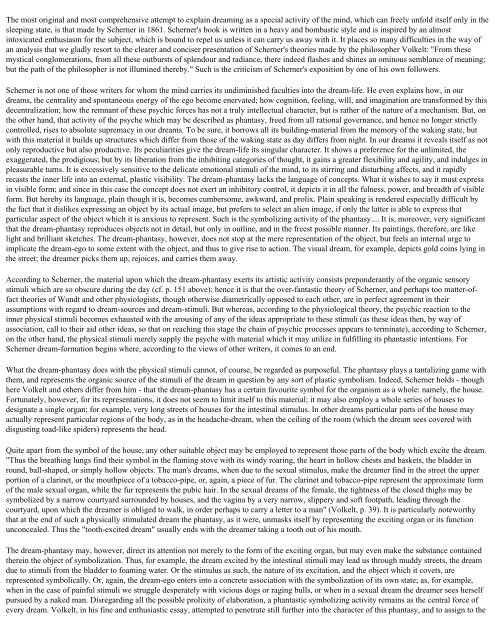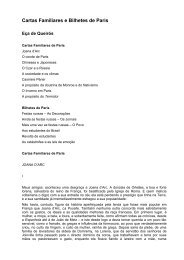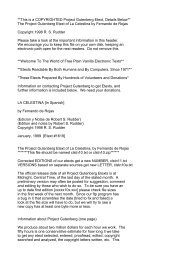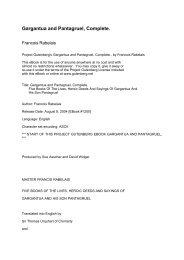The Interpretation of Dreams Sigmund Freud (1900)
The Interpretation of Dreams Sigmund Freud (1900)
The Interpretation of Dreams Sigmund Freud (1900)
Create successful ePaper yourself
Turn your PDF publications into a flip-book with our unique Google optimized e-Paper software.
<strong>The</strong> most original and most comprehensive attempt to explain dreaming as a special activity <strong>of</strong> the mind, which can freely unfold itself only in the<br />
sleeping state, is that made by Scherner in 1861. Scherner's book is written in a heavy and bombastic style and is inspired by an almost<br />
intoxicated enthusiasm for the subject, which is bound to repel us unless it can carry us away with it. It places so many difficulties in the way <strong>of</strong><br />
an analysis that we gladly resort to the clearer and conciser presentation <strong>of</strong> Scherner's theories made by the philosopher Volkelt: "From these<br />
mystical conglomerations, from all these outbursts <strong>of</strong> splendour and radiance, there indeed flashes and shines an ominous semblance <strong>of</strong> meaning;<br />
but the path <strong>of</strong> the philosopher is not illumined thereby." Such is the criticism <strong>of</strong> Scherner's exposition by one <strong>of</strong> his own followers.<br />
Scherner is not one <strong>of</strong> those writers for whom the mind carries its undiminished faculties into the dream-life. He even explains how, in our<br />
dreams, the centrality and spontaneous energy <strong>of</strong> the ego become enervated; how cognition, feeling, will, and imagination are transformed by this<br />
decentralization; how the remnant <strong>of</strong> these psychic forces has not a truly intellectual character, but is rather <strong>of</strong> the nature <strong>of</strong> a mechanism. But, on<br />
the other hand, that activity <strong>of</strong> the psyche which may be described as phantasy, freed from all rational governance, and hence no longer strictly<br />
controlled, rises to absolute supremacy in our dreams. To be sure, it borrows all its building-material from the memory <strong>of</strong> the waking state, but<br />
with this material it builds up structures which differ from those <strong>of</strong> the waking state as day differs from night. In our dreams it reveals itself as not<br />
only reproductive but also productive. Its peculiarities give the dream-life its singular character. It shows a preference for the unlimited, the<br />
exaggerated, the prodigious; but by its liberation from the inhibiting categories <strong>of</strong> thought, it gains a greater flexibility and agility, and indulges in<br />
pleasurable turns. It is excessively sensitive to the delicate emotional stimuli <strong>of</strong> the mind, to its stirring and disturbing affects, and it rapidly<br />
recasts the inner life into an external, plastic visibility. <strong>The</strong> dream-phantasy lacks the language <strong>of</strong> concepts. What it wishes to say it must express<br />
in visible form; and since in this case the concept does not exert an inhibitory control, it depicts it in all the fulness, power, and breadth <strong>of</strong> visible<br />
form. But hereby its language, plain though it is, becomes cumbersome, awkward, and prolix. Plain speaking is rendered especially difficult by<br />
the fact that it dislikes expressing an object by its actual image, but prefers to select an alien image, if only the latter is able to express that<br />
particular aspect <strong>of</strong> the object which it is anxious to represent. Such is the symbolizing activity <strong>of</strong> the phantasy.... It is, moreover, very significant<br />
that the dream-phantasy reproduces objects not in detail, but only in outline, and in the freest possible manner. Its paintings, therefore, are like<br />
light and brilliant sketches. <strong>The</strong> dream-phantasy, however, does not stop at the mere representation <strong>of</strong> the object, but feels an internal urge to<br />
implicate the dream-ego to some extent with the object, and thus to give rise to action. <strong>The</strong> visual dream, for example, depicts gold coins lying in<br />
the street; the dreamer picks them up, rejoices, and carries them away.<br />
According to Scherner, the material upon which the dream-phantasy exerts its artistic activity consists preponderantly <strong>of</strong> the organic sensory<br />
stimuli which are so obscure during the day (cf. p. 151 above); hence it is that the over-fantastic theory <strong>of</strong> Scherner, and perhaps too matter-<strong>of</strong>fact<br />
theories <strong>of</strong> Wundt and other physiologists, though otherwise diametrically opposed to each other, are in perfect agreement in their<br />
assumptions with regard to dream-sources and dream-stimuli. But whereas, according to the physiological theory, the psychic reaction to the<br />
inner physical stimuli becomes exhausted with the arousing <strong>of</strong> any <strong>of</strong> the ideas appropriate to these stimuli (as these ideas then, by way <strong>of</strong><br />
association, call to their aid other ideas, so that on reaching this stage the chain <strong>of</strong> psychic processes appears to terminate), according to Scherner,<br />
on the other hand, the physical stimuli merely supply the psyche with material which it may utilize in fulfilling its phantastic intentions. For<br />
Scherner dream-formation begins where, according to the views <strong>of</strong> other writers, it comes to an end.<br />
What the dream-phantasy does with the physical stimuli cannot, <strong>of</strong> course, be regarded as purposeful. <strong>The</strong> phantasy plays a tantalizing game with<br />
them, and represents the organic source <strong>of</strong> the stimuli <strong>of</strong> the dream in question by any sort <strong>of</strong> plastic symbolism. Indeed, Scherner holds - though<br />
here Volkelt and others differ from him - that the dream-phantasy has a certain favourite symbol for the organism as a whole: namely, the house.<br />
Fortunately, however, for its representations, it does not seem to limit itself to this material; it may also employ a whole series <strong>of</strong> houses to<br />
designate a single organ; for example, very long streets <strong>of</strong> houses for the intestinal stimulus. In other dreams particular parts <strong>of</strong> the house may<br />
actually represent particular regions <strong>of</strong> the body, as in the headache-dream, when the ceiling <strong>of</strong> the room (which the dream sees covered with<br />
disgusting toad-like spiders) represents the head.<br />
Quite apart from the symbol <strong>of</strong> the house, any other suitable object may be employed to represent those parts <strong>of</strong> the body which excite the dream.<br />
"Thus the breathing lungs find their symbol in the flaming stove with its windy roaring, the heart in hollow chests and baskets, the bladder in<br />
round, ball-shaped, or simply hollow objects. <strong>The</strong> man's dreams, when due to the sexual stimulus, make the dreamer find in the street the upper<br />
portion <strong>of</strong> a clarinet, or the mouthpiece <strong>of</strong> a tobacco-pipe, or, again, a piece <strong>of</strong> fur. <strong>The</strong> clarinet and tobacco-pipe represent the approximate form<br />
<strong>of</strong> the male sexual organ, while the fur represents the pubic hair. In the sexual dreams <strong>of</strong> the female, the tightness <strong>of</strong> the closed thighs may be<br />
symbolized by a narrow courtyard surrounded by houses, and the vagina by a very narrow, slippery and s<strong>of</strong>t footpath, leading through the<br />
courtyard, upon which the dreamer is obliged to walk, in order perhaps to carry a letter to a man" (Volkelt, p. 39). It is particularly noteworthy<br />
that at the end <strong>of</strong> such a physically stimulated dream the phantasy, as it were, unmasks itself by representing the exciting organ or its function<br />
unconcealed. Thus the "tooth-excited dream" usually ends with the dreamer taking a tooth out <strong>of</strong> his mouth.<br />
<strong>The</strong> dream-phantasy may, however, direct its attention not merely to the form <strong>of</strong> the exciting organ, but may even make the substance contained<br />
therein the object <strong>of</strong> symbolization. Thus, for example, the dream excited by the intestinal stimuli may lead us through muddy streets, the dream<br />
due to stimuli from the bladder to foaming water. Or the stimulus as such, the nature <strong>of</strong> its excitation, and the object which it covets, are<br />
represented symbolically. Or, again, the dream-ego enters into a concrete association with the symbolization <strong>of</strong> its own state; as, for example,<br />
when in the case <strong>of</strong> painful stimuli we struggle desperately with vicious dogs or raging bulls, or when in a sexual dream the dreamer sees herself<br />
pursued by a naked man. Disregarding all the possible prolixity <strong>of</strong> elaboration, a phantastic symbolizing activity remains as the central force <strong>of</strong><br />
every dream. Volkelt, in his fine and enthusiastic essay, attempted to penetrate still further into the character <strong>of</strong> this phantasy, and to assign to the









